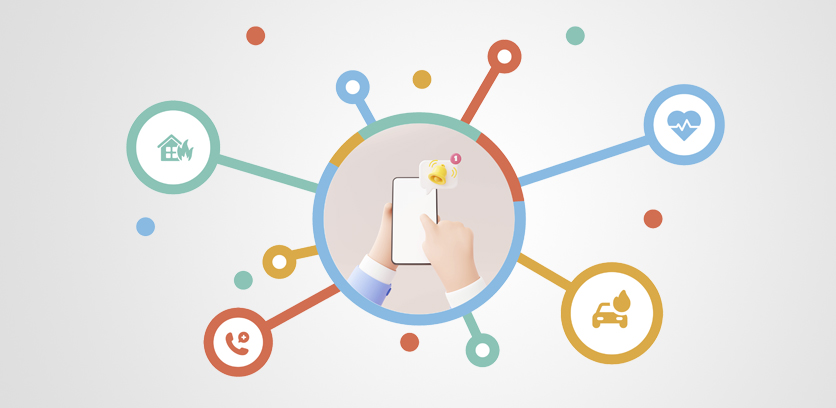
WhatsApp for Business
December 21, 2023
Contact Center As a Service
December 21, 2023An In-Depth Guide to Enterprise Notifications
In today’s business landscape, many modern enterprises rely on dispersed workforces to function. However, when employees connect remotely and stakeholders are spread across the globe, effective communication becomes challenging. In such scenarios, an enterprise messaging platform is a valuable tool for an organization to streamline outbound communications.
An enterprise messaging platform or enterprise notification system enables large organizations to send relevant alerts and information on multiple channels to different stakeholders using lists, locations, and visual intelligence. It can be used for both routine and emergency communication.
The need for enterprise notifications
Traditionally, emergency communications were dispensed through sirens and radio or TV broadcasts. They were later replaced by voice calls and SMS alerts. However, with modern enterprises catering to customers on different communication channels, these systems turn out to be inadequate.
For instance, imagine there is a crisis. One or more commonly used communication channels may be unavailable in such a situation. Hence, it will be ineffective in delivering time-sensitive and perhaps even life-saving messages to the intended audience.
So, traditional notification arrangements do not level up when it is necessary to send emergency communication to users at different levels before, during, and after critical events. We should also remember that the risk of error is high when manually disseminating information across multiple channels in an emergency.
Even for routine operations, traditional notification systems turn out to be slow, unreliable, and often ineffective in communicating the right message to the right person.
Enterprise notification systems overcome the various pitfalls of traditional notification systems. They ensure that messages get through even if one or more communication channels are down. So, how do they work?
Let us find out.
What does an Enterprise Notifications System do?
Organizations use different ways of communicating with staff and customers; SMS, Emails, WhatsApp messaging, website information, voice calls, social media, and more. While these channels may work for routine operations, they are seldom effective during emergency conditions like weather disruptions, security threats, and power outages.
An enterprise notification system allows organizations to send multiple-channel messages in real-time. These systems are fully equipped to handle various media types like voice, Email, SMS, and WhatsApp, and they seamlessly integrate with existing telephony platforms.
Effective enterprise notification servers also feature extended IVR functionalities and easy-to-use web interfaces. They have advanced capabilities like integrated text to Speech and APIs and SDKs for third-party application integration.
By facilitating multimodal notifications and pre-defining the workflow, these systems enable large organizations to achieve successful outcomes in daily operations and during crisis.
Enterprise notification systems are not just a tool for alerting during times of crisis. The system also works towards improving enterprise communications for routine needs and streamlining the outbound communications of an organization.
Here are the various ways in which enterprise notification systems benefit organizations.
4 Notable Benefits of Enterprise Notification Systems
1. Builds organizational resilience
According to the World Economic Forum Global Risks Report 2022, businesses have become increasingly vulnerable to threats in the last decade. Disruptions like natural disasters, pandemics, civil unrest, data breaches, and cyberattacks impact business confidence and affect productivity and revenue.
Given the growing nature of threats and disruptions, enterprises must be prepared for unexpected disruptions. They must build resilience by investing in technology and solutions that help them bounce back faster after unexpected disruptions to operations.
Enterprise notification systems are the first step to realizing this goal. This technology enables businesses to automate manual processes and improve response quality by reaching the right message to the right person at the right time.
2. Improves efficiency of communication
Enterprise notification systems make the dissemination of information faster.
During emergencies, speedy responses and reliable information allow departments and staff to act faster to bring positive outcomes. An effective enterprise messaging platform prevents lapses in communicating time-sensitive information that can negatively impact revenue, productivity, and brand reputation.
An efficient enterprise notification system plays an equally important role in improving routine communications.
The staff and customers of an organization may use more than one channel of communication—emails, voice calls, SMS, WhatsApp, social media chats, etc. A mass notification system enables organizations to send out alerts on all channels so they are more likely to see it, whether they are on their handheld devices or laptops and desktops. This improves the likelihood of positive responses.
3. Reduces human effort and chances for error in outbound communications
In a crisis, key responders are under higher stress. When their cognitive capabilities are reduced, a pre-defined response plan and availability of messaging templates reduce the risk of sending wrong messages, incomplete information, or no message at all.
Effective enterprise notification systems are optimized for successful event resolutions in times of crisis. The robust server can handle higher usage demands whenever required. Responses can be triggered instantly and real-time information sent to the teams that need it.
Additionally, the simple user interface and canned templates do not overwhelm users and make it easier for them to send out relevant and accurate information.
4. Supports marketing campaigns
The scope of an enterprise notification server extends beyond emergency responses. Campaign managers and marketing teams can also use it for targeted marketing. These systems allow administrators to set up groups, edit user preferences, and schedule communications for better marketing outcomes.
They support multiple contacts and bulk messaging, so you can use them to broadcast targeted messages to virtually any audience—individuals or groups. Manual effort is significantly reduced as the system automatically optimizes the same message for multiple channels.
Furthermore, it can publish messages to the department or organization’s social media accounts like Facebook and Twitter to enhance reach. The platform also generates reports and data for analyzing and tweaking the organization’s communication strategy.
In a nutshell….
Disruptions are an evolving threat in today’s business landscape. Hence, organizations across market segments must focus on building resilience to safeguard assets and sustain operational efficiency.
Merely having an emergency preparedness plan is not enough to overcome emerging threats. Proactive steps are essential to ensure employee and asset safety. Speed and responsiveness are essential for handling critical events successfully, and this is where an Enterprise notification System comes into the picture.
With an enterprise messaging platform, organizations can instantly send targeted information to desired contacts. Thus, it allows organizations and local authorities to reach their audience before, during, and after critical events and routinely, and expedite positive resolutions.




